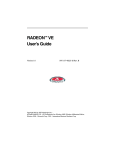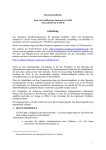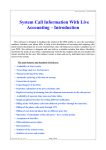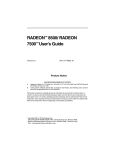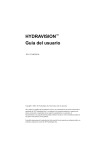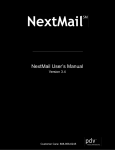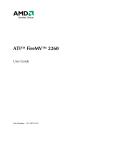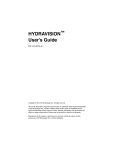Download Appian Hurricane User guide
Transcript
Appian Hurricane Multiple Monitor Graphics Card User Guide Copyright © 2001 Appian Graphics Corporation All rights reserved. This document may not be copied or otherwise reproduced without the prior written consent of Appian Graphics Corp. Printed in the USA. Text Part No. 780-00274-00 Appian Graphics, Hurricane, AGX1, AppianDX, AppianSync, HydraThread and HydraVision are trademarks and registered trademarks of Appian Graphics Corp. All other products and names are trademarks and registered trademarks of their respective owners. This material is made available for use under a license from Appian Graphics Corp. and its use is subject to all conditions and restrictions provided by the license agreement. Appian software programs and Appian hardware devices are covered by one or more of the following U.S. patents: 5,835,090 5,848,294 5,949,437 Additional patents are pending. ii How to Contact Appian Graphics In the United States (US), as well as Europe, the Middle East, and Africa (EMEA), use the following information to get help fast: General 425-882-2020 (US) +44 (0)20 7499-2535 (EMEA) Sales 800-727-7426 (US) Technical Support 800-422-7369, 7am – 5pm PST (US) +44 (0)20 7499-2535 (EMEA) Fax 425-882-8618 (US) +44 (0)20 7495-7636 (EMEA) Address (US) Appian Graphics Corp. 18005 NE 68th Street, Suite A120 Redmond, WA 98052 Address (EMEA) Appian Graphics Ltd. Top Floor, 73 New Bond Street London, W1S 1RS United Kingdom Email [email protected] (US) [email protected] (EMEA) Web site www.appian.com Information We Will Need Please have the following information available before you contact Appian Technical Support: Ÿ The name and serial number of your Appian product Ÿ Information about your computer; including the manufacturer, the system BIOS, the type/brand/model of your monitor(s), and other devices installed in your system. Ÿ A detailed description of the problem iii Contents Chapter 1 1 Introduction to Hurricane ............................................. 1 Included with the Hurricane ................................................2 Using Multiple Monitors .......................................................3 Chapter 2 4 Get Started.................................................................... 4 General System Requirements ............................................4 Prepare for Hardware Installation ........................................4 Install the Hurricane...........................................................5 Hurricane Monitor Cabling...................................................6 Chapter 3 8 Install and Use Software for Windows NT 4.0............ 8 Install the Windows NT 4.0 Driver and HydraVision Software..9 Install Local Help Files ...................................................... 10 Use HydraVision .............................................................. 11 Multi-Monitor Controls.................................................. 15 Desktop Management Controls ..................................... 18 Hot Keys Controls ....................................................... 22 MultiDesk ................................................................... 23 Chapter 4 25 Install and Use Software for Windows 98/ME/200025 Install the Windows 98/ME Driver ..................................... 26 Install the Windows 2000 Driver ........................................ 27 Enable Additional Monitors ................................................ 28 Install Local Help Files ...................................................... 29 Use HydraVision .............................................................. 30 Desktop Management Controls ..................................... 32 Hot Keys Controls ....................................................... 37 MultiDesk ................................................................... 38 Chapter 5 40 Technical Information................................................. 40 Monitor Cables and Connector Pinouts ............................... 40 DVI Connector Pinouts ................................................ 41 DB-15 Connector Pinouts ............................................. 42 Functional Specifications ................................................... 43 iv Chapter 6 44 Troubleshooting .......................................................... 44 Frequently Asked Questions .............................................. 44 Uninstall Hurricane Drivers and HydraVision Software ........ 48 Appendix A 49 Regulatory Information .............................................. 49 FCC Compliance Statement .............................................. 49 Industry Canada Compliance Statement ............................ 50 CE Compliance Statement ................................................ 50 Figures and Tables Figure Figure Figure Figure Figure Figure Figure Figure Figure Figure Figure Figure Figure Figure Figure Figure Figure Figure Figure Figure Figure 1. Hurricane Connectors ...........................................6 2. DVI-to-VGA Adapter .............................................6 3. Dual Monitor Array ............................................. 11 4. HydraVision Syste m Tray Icon............................. 12 5. Accessing HydraVision for Windows NT 4.0 ........... 12 6. Display Properties Dialog Box Example ................ 13 7. Multi-Monitor Dialog Example............................... 15 8. Extended Display Settings Dialog Example............ 16 9. Desktop Management Dialog Example .................. 18 10. Hot Keys Dialog Example .................................. 22 11. MultiDesk System Tray Icon .............................. 23 12. MultiDesk Pop-Up Menu..................................... 24 13. Enable Additional Monitors Example.................... 28 14. HydraVision System Tray Icon ........................... 30 15. Accessing HydraVision ...................................... 30 16. Desktop Management Dialog Example ................ 32 17. Hot Keys Dialog Example .................................. 37 18. MultiDesk System Tray Icon .............................. 38 19. MultiDesk Pop-Up Menu..................................... 39 20. DVI Connector Pinouts ...................................... 41 21. DB-15 Connector Pinouts .................................. 42 Table 1. DVI Connector Description ................................... 41 Table 2. DB-15 Connector Pinouts ..................................... 42 v [This page intentionally left blank.] vi Chapter 1 Introduction to Hurricane Thank you for purchasing the Appian Hurricane multiple monitor graphics card. This guide introduces you to Appian Hurricane architecture, performance capabilities and included software. This guide also contains an overview of HydraVision display management software, details about video support, and important technical information. Be sure to read this entire User Guide. The Hurricane provides dual-monitor support. With two display channels, the Hurricane is designed to support multiple monitor configurations in Windows 98/ME, Windows 2000 and Windows NT 4.0. The Hurricane card is a single-slot, multiple monitor graphics solution featuring a high-speed PCI or AGP bus interface, 32MB of on-board SDRAM (Synchronous Dynamic Random Access Memory), and full VGA and SVGA compatibility. The card interface to the PCI (versions 2.1 and above) or AGP (1X, 2X or 4X) bus incorporates multi-function capabilities for complete multiple monitor operating system support. The result is a fast, high-resolution display. The Hurricane also features Appian’s powerful and easy-to-use HydraVision multiple monitor desktop management software for Windows 98/ME, Windows 2000 and Windows NT 4.0. HydraVision software allows the user to define the placement and behavior of windows and dialog boxes in the multiple monitor display space, and provides a variety of productivity tools designed specifically for managing multiple monitors. 1 Chapter 1: Introduction to Hurricane HydraVision display management software provides language support for Brazilian Portuguese, Danish, Dutch, Finnish, French, German, Italian, Japanese, Korean, Norwegian, Spanish, Swedish, Simplified Chinese and Traditional Chinese. If you are running Windows in any of the above languages, HydraVision will automatically load the appropriate localized control panel or tab. If you are running Windows in a non-supported language, HydraVision and the local help files will be available in English only. Included with the Hurricane Before using your Hurricane hardware and software, please verify that your package contains the items listed below. Ÿ Appian Hurricane AGP or PCI graphics card Ÿ Appian Hurricane Installation CD-ROM Ÿ Registration/Warranty Card Ÿ DVI-to-VGA adapter Please contact Appian Technical Support if you find any of these items missing or damaged. Fill out and return the registration/warranty card to ensure full support from Appian for your Hurricane product. To get the best performance from your Hurricane card, use the supplied Windows 98/ME, Windows 2000 or Windows NT 4.0 drivers and HydraVision display management software. Each operating system requires a separate program for configuring displays. Be sure to use the appropriate device drivers and configuration program for your operating system. Appian Hurricane User Guide 2 Using Multiple Monitors The Hurricane supports the use of multiple monitors in Windows 98/ME, Windows 2000 and Windows NT 4.0. Using a multiple monitor configuration is an efficient and cost-effective way to increase the size of your computer display area, commonly called the desktop. With multiple monitors, you can view a single application as a large window stretching across several monitors, or you can display different applications on each monitor. 3 Chapter 1: Introduction to Hurricane Chapter 2 Get Started General System Requirements Ÿ A PC platform with a full-length PCI or AGP slot compliant with PCI revision 2.1 or higher, or AGP revision 2.0 or higher Ÿ Windows 98/ME, Windows 2000 or Windows NT 4.0 with Service Pack 4 or higher Ÿ Pentium II class processor Ÿ At least 32MB of installed system memory (RAM), or twice as much system RAM as graphics memory The Hurricane is VGA compatible and provides full support for Super VGA drivers written to Video Electronics Standards Association (VESA) specifications. Prepare for Hardware Installation To complete the installation, you may need some or all of the following tools: Ÿ Medium size flat head screwdriver Ÿ Medium size Phillips head screwdriver Ÿ 3/16” wrench or nut driver To prepare your computer for installation of the Hurricane card, perform the following steps: 1. Turn off the computer and the power for all external devices (monitor, printer, etc.). Appian Hurricane User Guide 4 2. Disconnect all cables from the rear of your computer to give you more room to work. Note where each cable connects so you can reconnect it after installing the Hurricane card. 3. Remove the cover-mounting screws on the computer. If necessary, refer to your system instruction manual for information on removing the computer cover. 4. Carefully remove the cover from the computer. The system motherboard should now be in full view. Install the Hurricane To install your Appian Hurricane card, perform the following steps: 5. Remove any previously installed graphics card(s) from the system. 6. Locate an available PCI or AGP expansion slot for the Hurricane card. If necessary, remove the expansion slot cover and partner screw using the appropriate tool. Ö WARNING! The Hurricane is static sensitive. To avoid damage to the card from static electricity, ground yourself before handling the card by touching the metal frame on your computer. This dissipates any static electricity and prevents damage to sensitive components. 7. Hold the Hurricane card by its top edge and slide it into the available slot. The PCI or AGP bus interface should fit into the slot. Make sure the Hurricane card is firmly seated in the slot. 8. Once the Hurricane card is correctly seated in the slot, secure it with the partner screw. 9. Replace and secure the computer cover. 10. Proceed to the monitor cabling section below. 5 Chapter 2: Get Started Hurricane Monitor Cabling The Hurricane card provides support for one DVI-I monitor or two VGA monitors using the supplied DVI-toVGA adapter. To connect the Hurricane card to the desired display devices, plug the monitor cable into the card (See Figure 1). To connect a DVI monitor to the Hurricane, use the supplied DVI-to-VGA adapter (Figure 2). To connect a VGA monitor to the DVI-I connector, attach the supplied DVI-to-VGA adapter to the DVI-I connector and plug your monitor cable into the adapter. Figure 1. Hurricane Connectors Figure 2. DVI-to-VGA Adapter Appian Hurricane User Guide 6 Once the cable installation is complete, you will be ready to load the provided device drivers and HydraVision display management software. To install the device driver for Windows NT 4.0, go to Chapter 3. To install the device driver for Windows 98/ME/2000, go to Chapter 4. 7 Chapter 2: Get Started Chapter 3 Install and Use Software for Windows NT 4.0 This chapter explains how to install and use the Hurricane Windows NT 4.0 driver and HydraVision desktop management software. HydraVision consists of a Desktop Manager that tracks windows and dialog boxes, a graphical user interface (GUI) control panel that allows you to control multiple monitors running in a single system, and the Appian MultiDesk utility. $ NOTE: For general information regarding driver installation in Windows NT 4.0, please refer to your Windows documentation. $ NOTE: Hurricane requires that you run Windows NT 4.0 with Service Pack version 4 or later. The Service Pack version number is shown on the blue start up screen. If you have an older Service Pack, upgrades are available from Microsoft (www.microsoft.com). Ö WARNING! To avoid possible conflicts, temporarily disable your virus protection software during installation of Hurricane software. You may reactivate virus protection after the installation is complete. Appian Hurricane User Guide 8 Install the Windows NT 4.0 Driver and HydraVision Software To install the Hurricane Windows NT 4.0 device driver and HydraVision software, perform the following steps: 1. Boot your system in VGA mode. From the boot menu, select Windows NT Workstation Version 4.0 [VGA Mode] at the prompt. 2. From the Windows Start menu, select Settings, then Control Panel. 3. Double-click the Display icon and select the Settings tab from the Display Properties dialog box. 4. Click the Display Type button. 5. Click the Change button. 6. Insert the Appian Hurricane installation CD-ROM. 7. Click the Have Disk button. 8. Select the path to the Windows NT driver file (.inf) using the Browse button. Click OK. 9. The Change Display window appears with the Appian driver displayed. Click OK. 10. A warning box from Windows appears stating that you are installing third-party software drivers. Click Yes to proceed. 11. The Hurricane driver files and HydraVision software are now installed, and a message appears confirming successful installation. Click OK. 12. You are returned to the Display Type window. Click Close to exit. 13. You are returned to the Display Properties dialog box. Click Close to exit. 9 Chapter 3: Software fo r Windows NT 4.0 14. You will now be prompted by Windows to restart your system. Click Yes. 15. Windows now restarts in single monitor mode. You can change the resolution and refresh rate for the Hurricane card from the Settings tab of the Display Properties dialog box. You can enable additional monitors from the Multi-Monitor tab of the Display Properties dialog box. $ NOTE: When selecting your analog display options, keep in mind that most applications require a color depth greater than 256 colors for optimal display. Install Local Help Files Appian Help provides a choice between connecting to on-line help or to local HTML-based help. Local HTMLbased help files can be installed from the CD-ROM that shipped with your product package. If you wish to have local HTML-based help files accessible from the Help button of the Display Properties dialog box, perform the following steps: $ NOTE: You must have an Internet browser installed on your system to view Appian help files. 1. Insert the Appian Hurricane installation CD-ROM into the appropriate drive. 2. Run the Help Setup program by selecting Run from the Windows Start menu and selecting the path to the Help setup.exe file (in the Help folder) using the Browse button. 3. Click OK. 4. Follow the program prompts to complete the installation. Appian Hurricane User Guide 10 Use HydraVision HydraVision software works with the Hurricane hardware and device drivers to create a seamless multiple monitor desktop. HydraVision allows multiple monitors connected to the Hurricane card to appear as one large display rather than several smaller ones. You can spread one application across all monitors or put a different application on each monitor. Figure 3. Dual Monitor Array The above figure shows four applications displayed on two monitors. The desktop and applications stretch across both monitors. HydraVision allows you to drag, drop and resize application windows to fit anywhere on a multiple monitor desktop. Using multiple monitors with Windows can be awkward when windows and dialog boxes are split across monitors or appear where they’re not wanted. The HydraVision Desktop Manager solves this problem by allowing you to set preferences for window and dialog box placement. HydraVision installation in Windows NT 4.0 enables the Appian Desktop Manager and adds the HydraVision display management software to your Windows Control Panel group, where it appears as additional tabs in the Display Properties dialog box. The HydraVision control panel allows you to adjust the Desktop Manager and other display options. 11 Chapter 3: Software fo r Windows NT 4.0 The Desktop Manager starts automatically with Windows. You can tell that HydraVision is running by the presence of the Appian icon in the Windows system tray. Figure 4. HydraVision System Tray Icon Right-click on this icon to access HydraVision features or help, or to unload the HydraVision Desktop Manager. In addition to accessing HydraVision from the system tray, you can also access HydraVision by right-clicking on the Windows desktop and selecting Properties. Figure 5. Accessing HydraVision for Windows NT 4.0 The HydraVision Desktop Manager allows you to adjust display options, such as hot keys, within a user-friendly graphical interface. $ NOTE: Some application windows and dialog boxes are not written to Windows standards. HydraVision may not be able to recognize and control these application’s windows and dialog boxes. Appian Hurricane User Guide 12 Figure 6. Display Properties Dialog Box Example The above figure shows an example of the Windows Display Properties dialog box with the Appian HydraVision tabs. All the normal Display Properties tabs are still available, including the Settings tab, which allows you to change desktop resolution and color depth for analog displays. The HydraVision tabs (Multi-Monitor, Desktop Management and Hot Keys) allow you to modify your display options. HydraVision also provides a dialog for extended display control, accessible from the Multi-Monitor tab. The Extended Display Settings dialog allows you to define and adjust each monitor in your system separately. 13 Chapter 3: Software fo r Windows NT 4.0 Along the bottom of each HydraVision dialog are four buttons: OK, Cancel, Apply and Help. ú OK implements the changes you’ve made in the Display Properties dialog box and exits the control panel. Changes take effect immediately unless you see a message prompting you to restart your computer. ú Cancel discards all changes made to any section of Display Properties and closes the dialog box. ú Apply implements your changes without closing the Display Properties dialog box. ú Help connects to either local or on-line HTMLbased help. You can also get context -sensitive on-screen help by moving your mouse over the relevant text for each control. Appian Hurricane User Guide 14 Multi-Monitor Controls Figure 7. Multi-Monitor Dialog Example The Multi-Monitor dialog features a graphic representation of the current monitor array. You can drag the monitor illustrations to new locations in the diagram to change the array. You can also enable and disable monitors by double-clicking on the monitor number in the list box. If the Enable Individual Monitor Refresh Rates box is checked, you can select independent refresh rates for each monitor in the system. Available refresh rates and other settings are contained in the Extended Display Settings dialog. To access the Extended Display Settings dialog, double-click on the individual monitor illustrations. 15 Chapter 3: Software fo r Windows NT 4.0 Extended Display Settings Figure 8. Extended Display Settings Dialog Example Refresh rate settings: ú Monitor Model—From the drop-down menu, select the model and brand of the monitor(s) you are using so that HydraVision can automatically determine the appropriate refresh rate for your display. This prevents manual selection of a refresh rate that is not supported by your monitor(s). If your monitor is not listed in the drop-down menu, it should still operate with the Hurricane card, as long as it is a multi-sync monitor. For monitors that are not listed, select Other and manually choose the desired refresh rate. Ö WARNING! Do not select a refresh rate higher than your monitor can support. Monitor damage may result. Appian Hurricane User Guide 16 ú Refresh Rate—HydraVision automatically determines the appropriate refresh rate for your monitor based on your model selection, as explained above. You may choose different refresh rates from the drop-down menu for each monitor. In general, a higher refresh rate improves display quality but lowers performance, because the graphics system can only do a fixed number of operations per second. The more time it spends redrawing the screen, the less time it has for other operations. Current Settings: This box indicates the current resolution of your monitors. To change the desktop size, go to the Windows Display Properties dialog box and select the Settings tab. Change the Desktop Area using the slider bar. $ NOTE: The Windows Settings dialog allows you to define the resolution of your desktop. The HydraVision Extended Display Settings dialog allows you to define the resolution of each monitor. If your monitors are set at different resolutions, a virtual desktop will be enabled on the monitor that is set to a lower resolution. Panning control: ú Panning is not enabled in Windows NT 4.0. 17 Chapter 3: Software fo r Windows NT 4.0 Desktop Management Controls Figure 9. Desktop Management Dialog Example The Desktop Management dialog lets you determine the behavior of pop-up windows and dialog boxes in a multiple monitor environment. Dialog Control: ú Enable dialog repositioning—Toggles dialog control on and off. When it is checked, you can choose to have dialog boxes appear on the parent application’s monitor (The parent application is the application that generated the dialog box.). If the parent application or associated monitor cannot be located, the dialog box defaults to Monitor 1. You can also choose to have dialog boxes appear on the monitor in which the cursor is located or to always appear on a specific monitor in the array. Appian Hurricane User Guide 18 $ NOTE: Windows system logon and logoff messages cannot be repositioned and will always appear split across monitors unless the Boot to single monitor control is enabled (see below). Window control: ú Single monitor windows—When this box is checked, windows are sized no larger than a single monitor. Windows that are placed on monitor splits are automatically relocated to the monitor on which most of the window appears. ú Max button management—Allows you to control the behavior of the Windows Maximize button. In a typical Windows environment, clicking the Maximize button causes a window to size itself to the full desktop. $ NOTE: Clicking the Appian icon on the application title bar makes the active window fill the current monitor, regardless of this setting. − Max to window corners causes windows to maximize to the monitor(s) that contains the window’s upper left and lower right corners. − Max to full desktop causes windows to maximize to the entire monitor array. − Max to current monitor causes windows to maximize to the monitor that contains the greatest portion of the window. ú Max child windows—Keeps windows generated by parent applications from splitting across monitors (A child window is a window residing within a parent application window.). The ability to keep child windows on a single monitor when maximized is extremely useful for editing multiple documents side by side in a parent application. 19 Chapter 3: Software fo r Windows NT 4.0 General: ú Application position memory—Check this box to “remember” the size and location of application windows when they are closed and reapply those settings when the application is reopened. ú Boot to single monitor—Check this box to boot your system in single monitor mode. This prevents system messages and the Windows splash screen from splitting across monitors during boot-up. The display will switch to multiple monitor mode after you log on and the Appian Desktop Manager loads. ú Remove Appian title bar buttons—Check this box to disable and remove the Appian icon, visible in the upper right corner of all active application title bars, which maximizes the active window and allows access to individual application settings. ú Remove Appian system tray icon—This box removes or restores the Appian system tray icon. ú Remove MultiDesk system tray icon—This box removes or restores the MultiDesk system tray icon. MultiDesk Settings—This button specifies desktop management settings for multiple desktops. Up to eight active desktops can reside in the background. This feature is explained later in this section. Appian Hurricane User Guide 20 Load/Unload Desktop Manager—This button restores or removes the HydraVision Desktop Manager. Unloading the Desktop Manager returns display settings to Windows defaults. You should only select this option if you do not want to use any multiple mo nitor dialog box and window controls or hot keys. $ NOTE: Unload applies to your current Windows session only. When Windows restarts, the Desktop Manager will reload. Load/Unload MultiDesk—This button restores or removes multiple desktop functionality. $ NOTE: Unload applies to your current Windows session only. When Windows restarts, MultiDesk will reload. Individual Application Settings—This button allows you to specify, enable and disable desktop management settings for individual applications. $ NOTE: These settings override the global settings defined in the Desktop Management dialog. 21 Chapter 3: Software fo r Windows NT 4.0 Hot Keys Controls Figure 10. Hot Keys Dialog Example The Hot Keys dialog allows you to specify hot key shortcuts for common operations such as starting applications, snapping applications to designated monitors and changing display resolution. Create/Remove Hot Keys To create custom hot key sequences, select a Modifier key (Shift, Alt, etc.), a Hot key, and the Hot key function you want this key combination to perform. Click Add to enter your new combination in the Assigned hot keys list box. Click Apply to activate assigned hot keys. Appian Hurricane User Guide 22 $ NOTE: Appian recommends that a modifier key be used with any function key (F1, F2, etc.) assigned as a hot key. This will prevent interference with the function of these keys in individual applications. To delete a hot key from the Assigned hot keys list box, highlight it, click Remove, and then click Apply. You can disable all hot keys listed in the Assigned hot keys list box by checking the Disable hot keys box near the bottom of the Hot Keys dialog. Use Hot Keys You can use any assigned hot key at any time, from within any application, to change your display. MultiDesk Appian’s HydraVision software supports multiple desktops. With MultiDesk, one active desktop will always be visible; while up to eight active desktops can reside in the background. When MultiDesk is running, the MultiDesk icon in the system tray displays the number assigned to the current desktop. Figure 11. MultiDesk System Tray Icon Right-click on this icon to access MultiDesk controls. In addition to accessing active desktops from the system tray, you can also access active desktops with a Hot key shortcut. 23 Chapter 3: Software fo r Windows NT 4.0 Figure 12. MultiDesk Pop-Up Menu To switch to another defined desktop, select the appropriate desktop number from the pop-up menu. To enable, disable and name active desktops, select MultiDesk Properties from the pop-up menu. To arrange applications within active desktops, or to enable specific applications on all desktops, select Arrange MultiDesk from the pop-up menu. $ NOTE: This applies to your current Windows session only. When Windows restarts, MultiDesk will reload. Appian Hurricane User Guide 24 Chapter 4 Install and Use Software for Windows 98/ME/2000 This chapter explains how to install and use the Hurricane Windows 98/ME and Windows 2000 drivers and HydraVision desktop management software. $ NOTE: For general information regarding driver installation in Windows 98 and Windows 2000, please refer to your Windows documentation. Ö WARNING! To avoid possible conflicts, temporarily disable your virus protection software during installation of Hurricane software. You may reactivate virus protection after the installation is complete. 25 Chapter 4: Software for Windows 98/ME/2000 Install the Windows 98/ME Driver To install the Hurricane Windows 98/ME device driver and HydraVision software, perform the following steps: 1. Upon boot-up of the system, the Add New Hardware Wizard will appear. Click Next. 2. Select the Display a list of known drivers… option and click Next. 3. Insert the Appian Hurricane installation CD-ROM into the appropriate drive. 4. Click Have Disk. 5. Select the path to the Windows 98 driver files (.INF) using the Browse button. Click OK. 6. If an Update Device Driver warning appears at this point, click Yes. 7. Click Next. 8. The Windows driver files are copied and a message appears, confirming successful installation. Click Finish. 9. You will be prompted to restart the system. Click Yes. 10. Windows now restarts in single monitor mode. You can enable additional monitors and change the resolution from the Settings tab of the Windows Display Properties dialog box (see section below). Appian Hurricane User Guide 26 Install the Windows 2000 Driver To install the Hurricane Windows 2000 device driver and HydraVision software, perform the following steps: 1. Upon boot-up of the system, Windows will automatically detect the new hardware and the Found New Hardware Wizard will appear. Click Next. 2. Select the Display a list of the known drivers… option and click Next. 3. Select Display Adapters and click Next. 4. Insert the Appian Hurricane installation CD-ROM into the appropriate drive. 5. Click Have Disk. 6. Select the path to the Windows 2000 driver file (.INF) on the CD-ROM using the Browse button. Click OK. 7. The Appian driver will be displayed. Click Next. 8. Click Yes, Click Next, click Yes. 9. The driver files for the device are installed. Click Finish to close the Wizard. 10. You will be prompted to restart the system. Click Yes. 11. Windows now restarts in single monitor mode. You can enable additional monitors and change the resolution from the Settings tab of the Windows Display Properties dialog box (see section below). 27 Chapter 4: Software for Windows 98/ME/2000 Enable Additional Monitors Figure 13. Enable Additional Monitors Example To enable additional monitors, perform the following steps: 1. From the Windows Start menu, select Settings, then Control Panel. 2. Double-click the Display icon. 3. Select the Settings tab. 4. Click the illustration of the monitor you wish to enable. 5. Check the Extend my Windows desktop onto this monitor check box, then click Apply. 6. You can also change the screen area (resolution) using the Screen area slider bar. Appian Hurricane User Guide 28 Install Local Help Files Appian Help provides a choice between connecting to on-line help or to local HTML-based help. Local HTMLbased help files can be installed from the CD-ROM that shipped with your product package. If you wish to have local HTML-based help files accessible from the Help button of the HydraVision control panel, perform the following steps: $ NOTE: You must have an Internet browser installed on your system to view Appian help files. 1. Insert the Appian Hurricane installation CD-ROM into the appropriate drive. 2. Run the help file Setup program by selecting Run from the Windows Start menu and selecting the path to the Help setup.exe file (in the Help folder) using the Browse button. 3. Click OK. Follow the program prompts to complete the installation. 29 Chapter 4: Software for Windows 98/ME/2000 Use HydraVision The Windows 98/ME and Windows 2000 operating systems are designed to recognize multiple monitors in a single system. HydraVision installation enables the Appian Desktop Manager and adds the HydraVision display management software to your Windows Control Panel group, where it appears as additional tabs in the Display Properties dialog box. HydraVision and the Appian Desktop Manager are activated whenever Windows starts. You can tell that HydraVision is running by the presence of the Appian icon in the Windows system tray. Figure 14. HydraVision System Tray Icon Right-click on this icon to access HydraVision features and help, or to unload the HydraVision Desktop Manager. In addition to accessing HydraVision from the system tray, you can also access HydraVision from the Windows Start menu under Programs. Figure 15. Accessing HydraVision Appian Hurricane User Guide 30 The HydraVision Desktop Manager allows you to modify your display options. You can access the Desktop Management and Hot Keys dialog boxes by clicking on the appropriate tab in the Desktop Manager. Along the bottom of each HydraVision dialog are four buttons: OK, Cancel, Apply and Help. ú OK implements the changes you’ve made in the HydraVision dialog and exits the Desktop Manager. Changes take effect immediately unless you see a message prompting you to restart your computer. ú Cancel discards all changes made to any section of the HydraVision dialog and closes the Desktop Manager. ú Apply implements your changes without closing the Desktop Manager. ú Help connects to either local or on-line HTMLbased help. You can also get context -sensitive on-screen help by moving your mouse over the relevant text for each control. 31 Chapter 4: Software for Windows 98/ME/2000 Desktop Management Controls Figure 16. Desktop Management Dialog Example The Desktop Management dialog lets you determine the behavior of pop-up windows and dialog boxes in a multiple monitor environment. $ NOTE: Depending on the operating system, not all the functions described in this section will be available. Appian Hurricane User Guide 32 Dialog control: ú Enable dialog repositioning—Toggles dialog control on and off. When it is checked, you can choose to have dialog boxes appear on the parent application’s monitor (The parent application is the application that generated the dialog box.). If the parent application or associated monitor cannot be located, the dialog box defaults to monitor 1. You can also choose to have dialog boxes appear on the monitor in which the cursor is located or to always appear on a specific monitor in the array. Window control: ú Single monitor windows—When this box is checked, windows are sized no larger than a single monitor. Windows that are placed on monitor splits are automatically relocated to the monitor on which most of the window appears. ú Appian Max/Restore or Max button management—Allows you to control the behavior of the Windows Maximize button. When HydraVision is running, an Appian icon appears in the upper right corner of your application title bars. Clicking this icon makes the active window maximize in one of the following ways: − Max to window corners causes windows to maximize to the monitor(s) that contain the window’s upper left and lower right corners. − Max to full desktop causes windows to maximize to the entire monitor array. − Max to current monitor causes windows to maximize to the monitor that contains the greatest portion of the window. 33 Chapter 4: Software for Windows 98/ME/2000 ú Max child windows—Keeps windows generated by parent applications from splitting across monitors (A child window is a window residing within a parent application window.). The ability to keep child windows on a single monitor when maximized is extremely useful for editing multiple documents side by side in a parent application. $ NOTE: The Appian application title bar icon changes from a single square to two smaller squares when a window is in an Appian maximized state. Clicking the icon again restores the active window to its default state as a single square. General: ú Application position memory—Check this box to “remember” the size and location of application windows when they are closed and reapply those settings when the application is reopened. ú Automatically align monitors—Under Windows, you can manually define monitor placement from the Settings dialog in the Display Properties dialog box. When this box is checked, HydraVision will override user-defined monitor placement if the monitors are not evenly aligned. $ NOTE: This control will work only if all monitors are running at the same resolution and your desktop is configured as a rectangle (monitors side by side). ú Boot to single monitor—Check this box to boot your system in single monitor mode. This prevents system messages and the Windows splash screen from splitting across monitors during boot-up. The display will switch to multiple monitor mode after you log on and the Appian Desktop Manager loads. Appian Hurricane User Guide 34 ú Enable individual application settings—Check this box to specify desktop management settings for individual applications. You can access these settings by clicking on the down arrow of the Appian icon in the application title bar or by pressing the Individual Application Settings button in the Desktop Management dialog. ú Remove Appian title bar buttons—Check this box to disable and remove the Appian icon, visible in the upper right corner of all active application title bars, which maximizes the active window and allows access to individual application settings. ú Remove Appian system tray icon—This box removes or restores the Appian system tray icon. ú Remove MultiDesk system tray icon—This box removes or restores the MultiDesk system tray icon. MultiDesk Settings—This button specifies desktop management settings for multiple desktops. Up to eight active desktops can reside in the background. This feature is explained later in this section. Load/Unload Desktop Manager—This button restores or removes the HydraVision Desktop Manager tracking program. Unloading the Desktop Manager returns display settings to Windows defaults. You should only select this option if you do not want to use any multiple monitor dialog box and window controls or hot keys. $ NOTE: Unload applies to your current Windows session only. When Windows restarts, the Desktop Manager will reload. 35 Chapter 4: Software for Windows 98/ME/2000 Load/Unload MultiDesk—This button restores or removes multiple desktop functionality. $ NOTE: Unload applies to your current Windows session only. When Windows restarts, MultiDesk will reload. Individual Application Settings—This button allows you to specify, enable and disable desktop management settings for individual applications. $ NOTE: These settings override the global settings defined in the Desktop Management dialog. Appian Hurricane User Guide 36 Hot Keys Controls Figure 17. Hot Keys Dialog Example HydraVision allows you to specify hot key shortcuts for common operations such as starting applications, snapping applications to designated monitors and changing display resolution. Create/Remove Hot Keys To create custom hot key sequences, select a Modifier key (Shift, Alt, etc.), a Hot key, and the Hot key function you want this key combination to perform. Click Add to enter your new combination in the Assigned hot keys list box. Click Apply to activate assigned hot keys. 37 Chapter 4: Software for Windows 98/ME/2000 $ NOTE: Appian recommends that a modifier key be used with any function key (F1, F2, etc.) assigned as a hot key. This will prevent interference with the function of these keys in individual applications. To delete a hot key from the Assigned hot keys list box, highlight it, click Remove, and then click Apply. You can also disable all hot keys listed in the Assigned hot keys list box by checking the Disable hot keys box near the bottom of the Hot Keys dialog. Use Hot Keys You can use any assigned hot key at any time, from within any application, to change your display. MultiDesk Appian’s HydraVision software supports multiple desktops. With MultiDesk, one active desktop will always be visible, while up to eight active desktops can reside in the background. When MultiDesk is running, the MultiDesk icon in the system tray displays the number assigned to the current desktop. Figure 18. MultiDesk System Tray Icon Right-click on this icon to access MultiDesk controls. In addition to accessing active desktops from the system tray, you can also access active desktops with a Hot key shortcut. Appian Hurricane User Guide 38 Figure 19. MultiDesk Pop-Up Menu To switch to another defined desktop, select the appropriate desktop number from the pop-up menu. To enable, disable and name active desktops, select MultiDesk Properties from the pop-up menu. To arrange applications within active desktops, or to enable specific applications on all desktops, select Arrange MultiDesk from the pop-up menu. The MultiDesk functionality can be removed by selecting Unload Appian MultiDesk from the pop-up menu. $ NOTE: This applies to your current Windows session only. When Windows restarts, MultiDesk will reload. 39 Chapter 4: Software for Windows 98/ME/2000 Chapter 5 Technical Information Monitor Cables and Connector Pinouts This section contains information about the connectors on your Hurricane card, as well as information about the connectors on the analog adapters. Appian Hurricane User Guide 40 DVI Connector Pinouts Figure 20 and Table 1 indicate pinouts for the standard DVI connectors on the Hurricane card. Digital displays use this type of connector. Figure 20. DVI Connector Pinouts Pin Allocation Pin Allocation High Speed Pins C1 Analog Red Video Out C4 Analog Horizontal Sync C2 Analog Green Video Out C5 Analog Ground Return C3 Analog Blue Video Out Main Pins 1 TMDS Data2- 13 TMDS Data3+ 2 TMDS Data2+ 14 +5V Power 3 TMDS Data2/4 Shield 15 Ground (Return for +5V Analog H/V Sync) 4 TMDS Data4- 16 Hot Plug Detect 5 TMDS Data4+ 17 TMDS Data0- 6 DDC Clock 18 TMDS Data0+ 7 DDC Data 19 TMDS Data0/5 Shield 8 Analog Vertical Sync 20 TMDS Data5- 9 TMDS Data1- 21 TMDS Data5+ 10 TMDS Data1+ 22 TMDS Clock Shield 11 TMDS Data1/3 Shield 23 TMDS Clock+ 12 TMDS Data3- 24 TMDS Clock- Table 1. DVI Connector Description 41 Chapter 5: Technical Information DB-15 Connector Pinouts Figure 21 and Table 2 indicate pinouts for the standard DB-15 connector on the Hurricane and analog adapters. Most analog monitors use this type of connector. 5 4 3 10 9 2 8 1 7 6 15 14 13 12 11 Figure 21. DB-15 Connector Pinouts Pin Allocation Pin Allocation 1 Red Video 8 Blue return (Ground) 2 Green Video 9 +5V DC (Fused) 3 Blue Video 10 Sync return (Ground) 4 Reserved 11 Reserved 5 Ground 12 SCL (DDC) 6 Red return (Ground) 13 Horizontal Sync 7 Green return (Ground) 14 Vertical Sync Continued in next column ä 15 SDA (DDC) Table 2. DB-15 Connector Pinouts Appian Hurricane User Guide 42 Functional Specifications Ÿ ATI Radeon VE graphics processor Ÿ Dual 300 MHz DAC Ÿ PCI or AGP bus interface ú PCI 2.1 and 2.2 compliant ú AGP revision 2.0 compliant Ÿ DDWG/DVI-i compliant Ÿ Driver support ú Windows NT 4.0 ú Windows 98/ME ú Windows 2000 Ÿ One standard DB-15 connector Ÿ One standard DVI-i connector 43 Chapter 5: Technical Information Chapter 6 Troubleshooting If you have a problem with your Hurricane card and don’t find the solution in this User Guide, please contact Appian Technical Support at 800-422-7369 or [email protected]. You can also visit the technical support section of the Appian web site at www.appian.com for the latest product support information, additional frequently asked questions and solutions to common installation and usage problems. Frequently Asked Questions What if my system won’t boot after installing the Hurricane card? Ÿ Make sure the Hurricane is properly seated in the PCI or AGP expansion slot. Ÿ Verify the slot is functioning properly by installing the card in a different PCI or AGP expansion slot. Ÿ Make sure all power cables are secure and properly connected. Ÿ Check your power source and verify that the power is turned on. Ÿ If you are using Windows NT 4.0: − Make sure other graphics cards have been removed from the system. − Make sure any on-board video is disabled. − Make sure you are using Service Pack 4 or later. Appian Hurricane User Guide 44 What if the Windows operating system warns that the graphics card is not configured properly? Ÿ Check the driver installation and ensure that all software corresponds to the operating system and is correctly loaded. Ÿ Reinstall the Hurricane driver. Ÿ Make sure drivers and utilities from previously installed graphics cards are removed/uninstalled from the system. 1. Select Start|Settings|Control Panel, double-click Add/Remove Programs. 2. Remove any drivers and utilities listed for graphics cards no longer in the system. Ÿ Check for address and interrupt conflicts to ensure the I/O and memory addresses reserved for the graphics card are not in use by other hardware devices. What if the Windows Device Manager shows a resource conflict between my Hurricane card and another system component? Disable any display adapters listed in the Device Manager other than the Hurricane card. 1. Right-click My Computer, select Properties. 2. Select the Device Manager tab. 3. Find Display Adapters and click on the plus sign (+) to the left. 4. Double-click the name of any display adapters listed other than the Hurricane card. 5. Check the Disable in this hardware profile box. 6. Shut down and restart the computer. 45 Chapter 6: Troubleshooting What if nothing displays on the monitor(s) connected to the Hurricane card? Ÿ Be sure the Hurricane card is properly seated in the PCI or AGP expansion slot and that cables are secure and properly connected. Ÿ Make sure the monitor is receiving power. Ÿ Check the pins on the monitor and cable connector(s) to ensure none are broken or bent. Ÿ The brightness or contrast controls on your monitor may not be adjusted correctly. Check and readjust these controls. Ÿ Make sure all monitors are enabled in the Display Properties dialog box. Ÿ Make sure the refresh rate is set correctly for each monitor. Ÿ Make sure the latest Appian display drivers are installed. Ÿ If you have a fixed frequency monitor, please contact Appian Technical Support. What if defects appear in my display? Ÿ Make sure that both the graphics card and monitor(s) support the resolution and refresh rates you have selected. Refer to your monitor’s documentation for recommended resolutions and refresh rates. Ÿ Make sure the latest Appian display drivers are installed. Appian Hurricane User Guide 46 Why do application boxes always appear on the primary monitor, when my application is on another monitor? In Windows 2000, most Microsoft Windowscompatible programs are multiple-monitor aware. However, many legacy applications are not. Some legacy applications will display their dialog boxes split either across two monitors, or only on the primary monitor, regardless of which monitor that application is running on. In many cases, Appian HydraVision and HydraVision can solve this problem through dialog repositioning. 1. Right-click the Appian icon on your taskbar. 2. Select Desktop Manager Configuration. 3. Select the Desktop Management tab. 4. Check the Enable dialog repositioning check box and choose one of the options listed underneath. 5. Click OK. What resolutions are best for use with my flat panel display? Most flat panel displays are designed to work best at a resolution of 1024x768. Consult the manual for your display hardware to determine the resolution for which your flat panel was designed. Where can I find the most recent software and documentation for the Hurricane card? The latest Appian drivers and display management software for the Hurricane are available from the Appian FTP site at ftp.appian.com. Up-to-date documentation can be obtained from the Appian web site at www.appian.com. 47 Chapter 6: Troubleshooting Uninstall Hurricane Drivers and HydraVision Software If you need to reinstall the Hurricane device drivers or HydraVision software for any reason, be sure to uninstall the driver and HydraVision files first. To uninstall the device drivers or HydraVision software, perform the following steps: $ NOTE: In Windows NT 4.0, you must be logged on as an administrator to successfully run the Appian uninstall utility. 1. Right-click on the MultiDesk system tray icon to access the MultiDesk menu and select Unload Appian MultiDesk. 2. Right-click on the Appian system tray icon to access the HydraVision menu and select Unload Desktop Manager. 3. Select Start|Settings|Control Panel. 4. Double-click Add/Remove Programs (98/ME) or Add/Remove Hardware (2000). 5. Select the appropriate Hurricane files. 6. Click the Remove button and follow any onscreen instructions. 7. When the uninstall process is complete, restart your system. Appian Hurricane User Guide 48 Appendix A Regulatory Information FCC Compliance Statement This equipment has been tested and found to comply with the limits for a Class B digital device pursuant to Part 15 of the FCC rules. These limits are designed to provide reasonable protection against harmful interference in a residential installation. This equipment generates, uses and can radiate radio frequency energy and, if not installed and used in accordance with the instructions, may cause harmful interference with radio communications. However, there is no guarantee that interference will not occur in a particular installation. If this equipment causes harmful interference with radio or television reception, which can be determined by turning the equipment off and on, the user is encouraged to try to correct the interference by one or more of the following measures: Ÿ Reorient or relocate the receiving antenna. Ÿ Increase the separation between the equipment and receiver. Ÿ Connect the equipment into an outlet on a circuit different from that to which the receiver is connected. Ÿ Consult the dealer or an experienced radio/TV technician for help. This device complies with Part 15 of the FCC Rules. Operation is subject to the following two conditions: 1) This device may not cause harmful interference, and 2) this device must accept any interference received, including interference that may cause undesired operation. 49 Appendix B: Disclaimer Changes or modifications to this device not expressly approved by Appian Graphics may void the user’s authority to operate the equipment. Industry Canada Compliance Statement This Class B digital apparatus meets all requirements of the Canadian Interference-Causing Equipment Regulations. Cet appareil numerique de la classe B respecte toutes les exigencies du Reglement sur le materiel brouilleur du Canada. CE Compliance Statement Electromagnetic Compatibility The manufacturer hereby declares that this device conforms to the following standards in accordance with the European Commission Directive 89/336/EEC: EN 55022:1998 EN 50082-1:1997 Appian Hurricane User Guide 50

























































